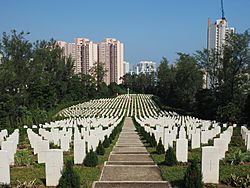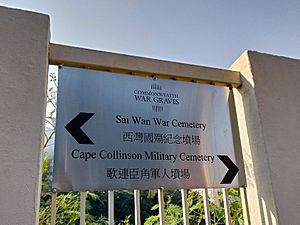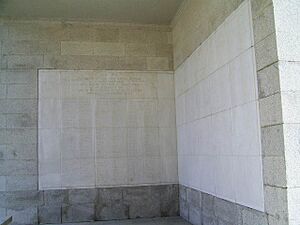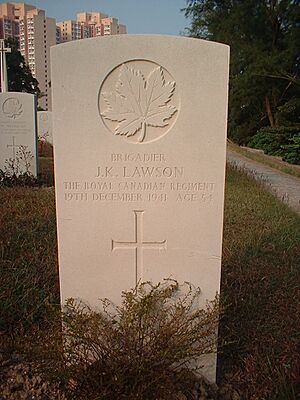Sai Wan War Cemetery facts for kids
Quick facts for kids Sai Wan War Cemetery |
|
|---|---|
| Commonwealth War Graves Commission | |

Sai Wan War Cemetery in Hong Kong
|
|
| For Battle of Hong Kong | |
| Unveiled | 1946 |
| Location | 22°15′34″N 114°14′04″E / 22.25944°N 114.23444°E near Chai Wan, Hong Kong
|
| Designed by | Colin St Clair Oakes |
| Total burials | 1,528 |
|
Unknowns
|
444 |
| Commemorated | 2,072 |
| Burials by war | |
| Statistics source: Commonwealth War Graves Commission | |
| Sai Wan War Cemetery | |||||||||||
|---|---|---|---|---|---|---|---|---|---|---|---|
| Traditional Chinese | 西灣國殤紀念墳場 | ||||||||||
| Simplified Chinese | 西湾国殇纪念坟场 | ||||||||||
|
|||||||||||
Sai Wan War Cemetery is a special place in Chai Wan, Hong Kong. It was built in 1946 to remember soldiers who bravely fought and died during World War II. Most of these soldiers were from countries like the UK, Canada, and India, which were part of the Commonwealth. There are also 12 soldiers from World War I buried here. In total, 1,528 soldiers are honored at this cemetery. It's a peaceful place where we can learn about the sacrifices made for freedom.
Contents
Why This Cemetery Is Important
The Battle for Hong Kong
On December 8, 1941, Japanese forces attacked Hong Kong. This happened just hours after the attack on Pearl Harbor. Hong Kong was a British colony at the time. Allied soldiers, mainly from Britain, India, and Canada, tried to defend it. However, the War Office had already decided that Hong Kong was very hard to defend.
Even so, the soldiers were told to fight hard. Many fierce battles took place in areas like Shing Mun Redoubt and Wong Nai Chung Gap. These fights led to many casualties among the Allied troops.
Japanese forces easily crossed from Shenzhen into Hong Kong. Indian Army battalions like the 5/7 Rajput and 2/14 Punjab fought bravely. They suffered many losses, with soldiers killed, missing, or wounded. The Hong Kong and Singapore Royal Artillery also had many casualties. Their names are written on panels at the cemetery entrance.
The battles on Hong Kong Island were intense. The British surrendered on Christmas Day that year. This began the Japanese occupation of Hong Kong, which lasted for three years.
Many soldiers died during the battle. Even more died later from sickness, drowning, or harsh treatment while they were prisoners of war. Most of these brave Allied soldiers were eventually buried at Sai Wan War Cemetery.
Who Is Remembered Here?
The Commonwealth War Graves Commission (CWGC) helps care for this cemetery. They note that 914 soldiers from Undivided India are remembered in three places within the cemetery. Some have tombstones, others are on a memorial, and 118 are on plaques because their remains were cremated. The Sai Wan War Cemetery also holds the graves of 228 Canadian soldiers.
Where Is Sai Wan War Cemetery?
The cemetery is on the western side of Pottinger Peak in north-eastern Hong Kong Island. It sits on the side of Mount Collinson, along Cape Collinson Road. The land gently slopes down towards where the sea used to be visible. This area, near Lei Yue Mun, was important. Japanese soldiers crossed the harbor here on December 18, 1941. That same night, 20 gunners at the Sai Wan Battery were killed.
Today, tall buildings in Chai Wan block some of the harbor view. On a clear day, you might still see Kowloon across the water. There are other cemeteries nearby, like the Holy Cross Roman Catholic Cemetery and the Cape Collinson Muslim and Buddhist Cemeteries.
Exploring the Cemetery
The cemetery was built in 1946. The Commonwealth War Graves Commission has looked after it since 1953. At the entrance, there is a memorial hall. It has panels with the names of over 2,000 Commonwealth soldiers. These are soldiers who died in the Battle of Hong Kong or later as prisoners. Some have no known grave.
Other panels remember 144 British Indian Army soldiers. Their names are listed because their remains were cremated according to their beliefs. There is also a memorial for 72 soldiers from both World Wars. Their graves in mainland China could not be cared for. Twenty local soldiers and eight civilians are also buried here. A map shows visitors how the battle unfolded.
The cemetery is built on a slope. British graves are at the top. Canadian and Dutch graves are in the middle. Graves of soldiers from Undivided India are at the lower part. Some graves of Indian soldiers who died in World War II were moved here from other cemeteries.
The graves are marked with white granite headstones. Each stone shows the symbol of the soldier's regiment or service. Flowering shrubs and bushes surround the cemetery. An Altar of Remembrance stands at the top of the steps. It has the words: "Their name liveth for evermore." A Cross of Sacrifice is at the bottom of the central aisle. Both the cemetery and memorial were designed by Colin St Clair Oakes.
The cemetery also holds the remains of POWs who died in Taiwan. They were brought here for burial. In total, 1,528 World War II casualties are buried or remembered at Sai Wan. About 444 of these burials are unidentified. Their headstones say: Known Unto God. There are also special memorials for 16 World War II casualties whose graves in a Kowloon Muslim cemetery were lost. Seventy-seven war graves of other nationalities, mostly Dutch, are also here. The cemetery also has special memorials for 12 World War I and 28 World War II graves. These were moved from other Muslim cemeteries due to city development.
Notable People Remembered Here
Around 280 Canadian soldiers are remembered here. This includes Brigadier John K. Lawson. He was the highest-ranking officer killed during the defense of Hong Kong. The Japanese first buried him at Wong Nai Chung Gap. Later, his remains were reburied at this cemetery. Two Major Generals, Lancelot Ernest Dennys and Merton Beckwith-Smith, are also buried here.
Company Sergeant-Major John Robert Osborn was awarded the Victoria Cross for his bravery in Hong Kong. He does not have a grave here, but his name is on the memorial hall.
Gallery
See also
- Stanley Military Cemetery
- List of cemeteries in Hong Kong












